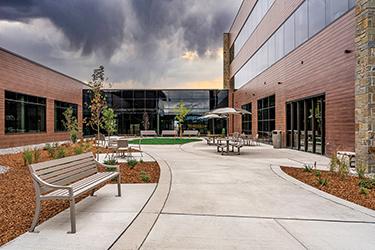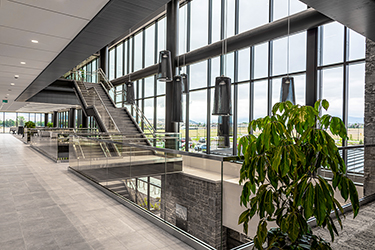|
Subscribe / Renew |
|
|
Contact Us |
|
| ► Subscribe to our Free Weekly Newsletter | |
| home | Welcome, sign in or click here to subscribe. | login |
Architecture & Engineering
| |
 |
February 29, 2024
The need for high-performance building enclosure design
Cushing Terrell

Gauer
|
There’s been something of a container renaissance recently. Whether you fall into the Stanley camp or the Yeti league, there’s been a renewed appreciation for vessels like these.
It’s not just a trend: A savvy consumer knows it’s all about smart design. A great bottle will keep your drinks appropriately hot or cold. They’ll keep the elements out and your beverage intact. Sure, you could use a regular old plastic bottle to hold your drink, but they’re far less likely to stand up to any sort of stress, and you can bet on a room-temperature sip after a short while. But invest in a quality product, and you can expect great results that last.
This is the same concept behind a high-performance building enclosure. If you invest in the right materials for your structure, ones that respond to both the occupants’ needs and the local environment, you set yourself up for a comfortable, responsive building that will stand the test of time.
WHAT IS BUILDING ENCLOSURE DESIGN?
Sometimes called a building envelope, the enclosure is the physical separator between the conditioned and unconditioned environment of a building. It determines its ability to resist air, water, heat, light, and noise transfer. Like our beverage vessel example, it’s both a barrier and a container.
The four key components of building enclosures are waterproofing, air tightness, insulation, and moisture vapor diffusion. Each of these components is considered for roof, wall, and below-grade surfaces, and is planned for at all openings, terminations, building transitions, and intersections of differing materials.
WATERPROOFING
At a basic level, the focus on waterproofing for building enclosures is to prevent water intrusion from rain, snow, groundwater, and more. Waterproofing a building may seem obvious, but investing in top-performing waterproof solutions can save you a lot of headaches (and money) in the long run.
Consider that water infiltration is consistently one of the top causes for insurance claims and contractor callbacks for business and residential building owners, which can inflate insurance rates, operating costs, and maintenance costs. Water can seep in through roofs, below-grade foundations, wall-system openings, and discontinuous waterproofing membrane transitions. Water damage might be covered by insurance, but the repair for the cause of the water intrusion often is not.
AIR TIGHTNESS
As the seasons change, there can be a loss of heating or cooling within a building. The best prevention for this occurrence is to keep the building envelope airtight, plugging any holes or gaps that could cause a leak. This may sound a lot like insulation, but the two tactics work best together to increase the building’s performance.
This even goes beyond a building’s temperature: When local outdoor air quality is poor, a building that allows air to leak within can also be a health risk.
INSULATION
As mentioned above, a building’s air tightness and insulation should work in tandem for the best building performance results. Insulation is key to ensuring the continuity of a building’s thermal insulation system. When these components are of high quality, it can lower HVAC operations that keep occupants comfortable and reduce the utility costs for the building owner.
Both insulation and air tightness also help with soundproofing and noise reduction, further improving the environment for the occupants and avoiding disturbances from the neighbors.
DIFFUSION
This final component helps prevent and manage moisture transfer through finished exterior materials. Water vapor diffusion is the movement of water molecules through a solid material from an area of higher concentration to an area of lower concentration. And as we highlighted in the importance of waterproofing, uncontrolled moisture can be both difficult and expensive to fix, often causing mold, rotted wood, corrosion, and freeze-thaw damage.
The building envelope that best controls moisture vapor diffusion can depend on the region (is it a wet or dry environment?), but also depends on what’s within the building’s walls. Interior environments that experience high indoor humidity levels — such as pools, manufacturing facilities, water treatment plants, or school gymnasiums — require special consideration to manage the diffusion of moisture vapor through wall and roof system components.
THINKING BEYOND EFFICIENCY
Selection and installation of a robust air barrier and appropriately accomplishing its interface with adjoining components and the system’s thermal insulation materials will directly improve a building’s efficiency. In other words, an optimal building envelope creates energy efficiency, and energy efficiency results in a smaller carbon footprint, making the building envelope a critical part of the resilient and sustainable design conversation.
PUTTING IT ALL INTO PRACTICE
There’s no one-size-fits-all solution, only an array of critical elements and components to consider such as client needs and the surrounding environment. Think of it as an if-then formula: If there are many points of entry, then there needs to be a closer examination of air tightness. If the building has an indoor pool, then there should be a focus on moisture diffusion.
Last year, the Cushing Terrell design team completed a clinic located in Bozeman, Mont., a region prone to large temperature swings and rainy and snowy conditions throughout the year. Knowing these environmental factors and the need to keep the interior safe and dry, the team opted for a roof drainage layout that uses tapered insulation to internal roof drains. To rigorously control moisture in a medical building where small atmospheric changes matter, we opted for a 10-mil polyethylene vapor barrier taped and sealed air tight behind the interior wall finishes. Within the wall, we installed fiberglass batt insulation in the stud cavity with a self-adhered air and moisture barrier placed over the entirety of the exterior sheathing.
These and our other building enclosure choices were also made with cost in mind: Both the up-front cost of the materials themselves and reducing potential expenses in the future (i.e., to avoid repairs and keep energy bills down).
By choosing appropriate and high-performance solutions for each of the building’s enclosure components — in a way that was responsive to its unique needs — we delivered a structure that will withstand the test of time by sealing the external environment out and protecting what’s located within. It’s not a trend, it’s just responsive design.
Brady Gauer is a roofing envelope specialist at Cushing Terrell.
Other Stories:
- Transforming yesterday’s spec office into the destination workplace of tomorrow
- Designing library spaces for the children of today
- Bypassing review to boost affordability
- Seattle’s commercial development at a crossroads
- Designing for health in affordable housing
- Disrupting inequality in housing
- Trends transforming life-science building design
- Eight trends shaping design for cities in 2024
- Centering the patient and community in rural healthcare design
- Engineering with support from the sky
- An uncertain forecast for middle housing




